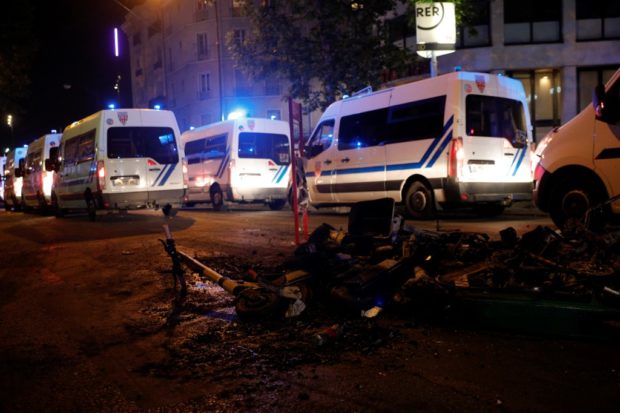Clashes at mass Paris protest over black man’s death in custody
PARIS, France —Some 20,000 people defied a ban in Paris on Tuesday to protest the 2016 death of a young black man in French police custody, some clashing with police and using slogans like those used in the demonstrations raging in the US.

A destroyed electric scooter is pictured as French police block a street at Porte de Clichy, in the northwest of Paris, on June 2, 2020 following a demonstration against police violence and in memory of late US citizen George Floyd who died a week before after a Minneapolis police officer knelt on his neck. Photo by GEOFFROY VAN DER HASSELT / AFP
The protesters rallied outside a Paris court despite a coronavirus ban on gatherings of more than 10 people, before clashes erupted involving tear gas, rubber bullets, burning barricades and projectiles.
They were protesting after the release of two differing medical reports into the cause of Adama Traore’s death, whose case has long been a rallying cry against police brutality in France.
Many of the protesters drew inspiration from the protest movement in the United States over the police killing last week of George Floyd, an unarmed black man, brandishing viral slogans in English such as “Black Lives Matter” and “I can’t breathe”.
The protest started in the late afternoon outside the court in northeast Paris, before projectiles were thrown and the police used tear gas to disperse the crowd, which scattered into the surrounding streets, AFP journalists witnessed.
Sporadic clashes broke out near the ringroad that encircles Paris, with stones thrown at the police, who responded by firing rubber bullets.
Article continues after this advertisementBarricades were erected in some streets.
Article continues after this advertisement“There were some incidents on the sidelines of the banned protest and security forces are intervening,” the Paris police prefecture tweeted. The police estimated that around 20,000 people attended the protest.
Earlier in the day Traore’s elder sister Assa spoke to the large crowd.
“Today we are not just talking about the fight of the Traore family. It is the fight for everyone. When we fight for George Floyd, we fight for Adama Traore,” she said.
“What is happening in the United States is an echo of what is happening in France.”
Protests were held across France, with 2,500 protesters attending a rally in the northern city of Lille, 1,800 in Marseille, and 1,200 in Lyon.
Duelling medical reports
The Traore case has long been controversial in France.
Following a dispute over an identity check, Traore, 24, was apprehended in a house where he hid after leading police on a 15-minute chase in 2016.
One of the three arresting officers has told investigators that they pinned Traore down with their combined bodyweight.
Traore lost consciousness in their vehicle and died at a nearby police station. He was still handcuffed when paramedics arrived.
On Friday, French medical experts exonerated the three police officers, saying that Traore did not die of “positional suffocation” but from “cardiogenic edema” linked to his poor health.
The findings, the third official report to clear the officers, dismissed a medical report commissioned by the young man’s family that said he had died of asphyxiation.
But on Tuesday a new probe commissioned by the Traore family said that his death was caused by the arrest technique used by the officers.
The duelling medical reports also echoes the case of George Floyd, whose preliminary autopsy said he died from pre-existing heart problems, while an autopsy arranged by his family found he died of asphyxiation from sustained pressure.
Floyd’s official autopsy then confirmed he died in a homicide involving “neck compression”.
‘Not violent, nor racist’
Paris police chief Didier Lallement, who banned the protest, earlier on Tuesday wrote a letter to police officers defending their conduct.
He said he sympathized with the “pain” officers must feel “faced with accusations of violence and racism, repeated endlessly by social networks and certain activist groups”.
The Paris police force “is not violent, nor racist: it acts within the framework of the right to liberty for all,” he insisted in an email to the city’s 27,500 law enforcers.
Several French officers have also been investigated for brutality against members of the public at long-running “yellow vest” anti-government rallies, and more recent anti-pension reform strikes.
Scores of protesters were maimed by rubber bullets or stun grenades, some losing an eye or a hand.
On January 3 this year, a 42-year-old man suffocated to death after being pinned face down to the ground during an arrest in Paris.
Last week, a 14-year-old was badly injured in one eye during a police operation in Bondy, one of Paris’s northern suburbs, sparking protests.